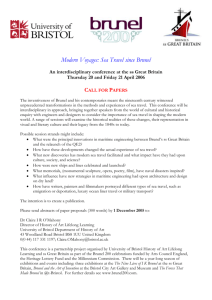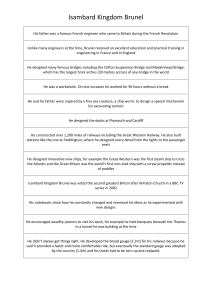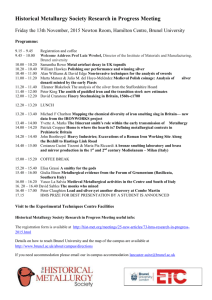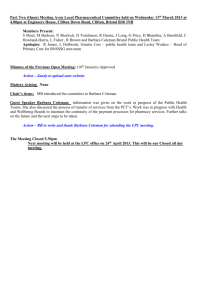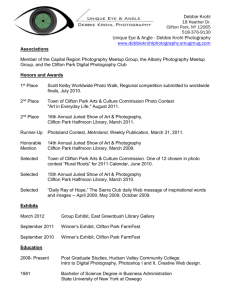Brunsel`s Clifton
advertisement
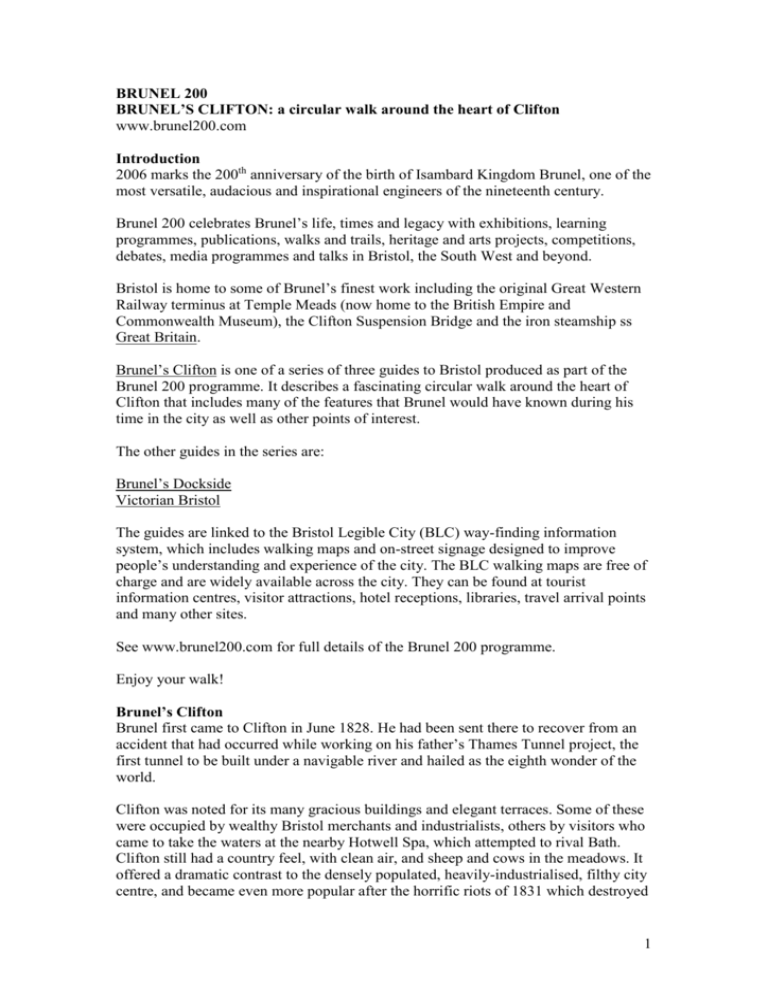
BRUNEL 200 BRUNEL’S CLIFTON: a circular walk around the heart of Clifton www.brunel200.com Introduction 2006 marks the 200th anniversary of the birth of Isambard Kingdom Brunel, one of the most versatile, audacious and inspirational engineers of the nineteenth century. Brunel 200 celebrates Brunel’s life, times and legacy with exhibitions, learning programmes, publications, walks and trails, heritage and arts projects, competitions, debates, media programmes and talks in Bristol, the South West and beyond. Bristol is home to some of Brunel’s finest work including the original Great Western Railway terminus at Temple Meads (now home to the British Empire and Commonwealth Museum), the Clifton Suspension Bridge and the iron steamship ss Great Britain. Brunel’s Clifton is one of a series of three guides to Bristol produced as part of the Brunel 200 programme. It describes a fascinating circular walk around the heart of Clifton that includes many of the features that Brunel would have known during his time in the city as well as other points of interest. The other guides in the series are: Brunel’s Dockside Victorian Bristol The guides are linked to the Bristol Legible City (BLC) way-finding information system, which includes walking maps and on-street signage designed to improve people’s understanding and experience of the city. The BLC walking maps are free of charge and are widely available across the city. They can be found at tourist information centres, visitor attractions, hotel receptions, libraries, travel arrival points and many other sites. See www.brunel200.com for full details of the Brunel 200 programme. Enjoy your walk! Brunel’s Clifton Brunel first came to Clifton in June 1828. He had been sent there to recover from an accident that had occurred while working on his father’s Thames Tunnel project, the first tunnel to be built under a navigable river and hailed as the eighth wonder of the world. Clifton was noted for its many gracious buildings and elegant terraces. Some of these were occupied by wealthy Bristol merchants and industrialists, others by visitors who came to take the waters at the nearby Hotwell Spa, which attempted to rival Bath. Clifton still had a country feel, with clean air, and sheep and cows in the meadows. It offered a dramatic contrast to the densely populated, heavily-industrialised, filthy city centre, and became even more popular after the horrific riots of 1831 which destroyed 1 the fashionable dwellings at the heart of the city in Queen Square. During Brunel’s 30-year association with Bristol five more grand terraces and several detached mansions were built in Clifton. Most of the walk is on the level but steeper sections and steps are indicated in the text with suggested easier alternative routes. The walk is about 1.5 km (one mile) long, including three optional detours. Allow one and a half hours to complete it. It can be joined at any point. The words Meeting Point are inserted in the text where alternative routes meet. Look out for the challenges for children. There are questions with answers at the end and other challenges to spot the unusual and curious in Clifton. The suggested starting point for the walk can be reached by using the number 8 bus service, operated by First, which runs frequently from Bristol Temple Meads station and the city centre. You can see the number 8 route marked on the BLC map. The bus stop you need is called ‘Clifton Village’ near the Rodney Hotel. On arrival at the stop, cross the road to the bus stop at the junction of Clifton Down Road and Boyce’s Avenue. This is the stop for the Bristol City Sightseeing open-top tour bus, which is in operation from Easter to September. See http://www.bristolvisitor.co.uk/ for timetable. It is also the stop for the return bus (service number 9) to the city centre and Temple Meads. The Walk Start at the bus stop where Boyce’s Avenue meets Clifton Down Road. With your back to Boyce’s Avenue, look across the road to the right. You will see the grand buildings and gardens of Rodney Place, a terrace of 1785. Among its famous residents was Humphry Davy, the chemist who invented the Miners’ Safety Lamp, and John Lambton, 1st Earl of Durham, who was Governor-General of Canada in 1830. He was the author of the Durham Report which suggested that Canada become independent. Paule Vezelay, famous for her abstract paintings, also lived in Rodney Place. Cross Clifton Down Road using the zebra crossing and walk down the right-hand side of Princess Victoria Street. The first shop on your right has a very handsome Victorian shop front, as does the one opposite the Somerset pub. Children’s Challenge Further down the street is Clifton’s former primary school built in 1852, now the Clifton Library. Question 1 - What is carved in the stone above the windows? Continue past Waterloo Street on the right. Pause when you reach The Mall. Look left at the ornate Edwardian baroque façade built in 1906 for a construction firm. In Brunel’s day these were the stables for the nearby Assembly Rooms in The Mall. Beyond lies the remainder of Princess Victoria Street, originally stables and coach houses for the grand houses of the wealthy which were turned first into motor garages and now into charming small homes with modern infilling of varying quality. 2 Turn right and walk up The Mall. Caledonia Place and The Mall Gardens now come into view on your left. Children’s Challenge Look up at the corner building across the road. The monogram NPU stands for National Provincial and Union – the name of the bank when it was built. Question 2 – What date was this bank built? The top end of these terraces was designed in the 1780s, but the far end, all with balconies, was not built until the 1830s. Cross to the wide pavement outside the bank, which still retains its lofty banking hall inside. Note to your right two unusual lamp standards. They date from 1893 and were amongst the first experimental electric streetlights in Bristol. As an effective incandescent filament had yet to be invented, their elongated shape housed a Victorian arc light. Gas street lighting would have existed in Brunel’s time and until 1900 was still standard. Most of the old gas lamps have since been converted to electricity. Cross to the cobbled paving close to the gardens to view the magnificent Assembly Rooms, built 1806-11, now a gentleman’s club. The building has a fine pediment displaying the coat of arms of the Huguenot developer, John Auriol. It has six Ionic columns and elegant bow fronts. The architect was Francis Howard Greenway. In 1812 he was convicted of forgery and transported to Australia. There he was employed by Governor Macquarie and designed over 40 major buildings in the Sydney area. He is regarded as the father of Australian architecture and for many years this forger’s head appeared on Australian banknotes. In 1830 Princess Victoria, the future queen, then aged 11, stayed at the hotel which formed part of the building while her mother showed her off to her future subjects. Now turn to look down the gardens. They are one of the finest of 35 communal gardens in Clifton, which were an ingenious solution to the problem of supplying every house in a terrace with the use of elegant ‘pleasure grounds’. Immediately in front of you in summer is a display of Lychnis chalcedonica, the Flower of Bristol, so named because Bristol produced a bright red cloth the colour of the flower. It was probably first introduced into England as a garden plant at the time of the Crusades. Cross back to the bank and walk down Caledonia Place. Note the magnificent electric lamp standards of 1905 that bear the city’s coat of arms. Enjoy the decorative doorways and the iron railings. It was originally intended to make a square here with Number 38 as its centrepiece. Number 35 still has the original number 17 painted above the door. Children’s Challenge Question 3 – What does the door knocker of Number 40 show? Stop on the pavement once you reach the dividing road between the two gardens. Look down the terrace. There are 24 mounting blocks that were used to help people climb into their carriages. The basements of the houses were the servants’ quarters and the kitchen. The ground floor was the dining room and parlour. The first floor was the finest with drawing rooms. The second and third floors contained bedrooms and 3 nurseries. The ground and first floors often retain folding doors between the front and back rooms. This enabled the two rooms to be used for lodgers, or turned into one for big social events. Water for general use was channelled from the roofs into a cistern in the cellar. Wells were sunk for drinking water. Bathrooms were a twentieth-century invention and they were added on to the back of the houses. Most lavatories were earth closets in the garden. Many of the houses retain their original internal wooden window shutters. Before central heating, each room had its own fireplace, which accounts for the distinctive rows of chimney pots, often 12 per house. The iron squares in the pavement are where coal was dropped into the cellars for storage. Now take the road between the gardens to the red pillar box opposite. Admire the variety of trees. Children’s Challenge Question 4 - What letters are on the pillar box? Turn right along the local pennant stone pavement of West Mall. Number 7 is the centre of the original terrace here. Children’s Challenge Look up at Numbers 7 and 5, which have fire-marks on their walls for the Royal Liver and Westminster Insurance companies. Until 1877, when councils took over, insurance companies ran private fire brigades, but would only attend fires in houses they had insured. Imagine the horses pulling a pump and galloping to the scene of a fire. The corner building housed a chemist’s shop established in 1832. It retains a magnificent painted ceiling and some original shop fittings. Look across The Mall to the attractive circular window of Number 28. Children’s Challenge Can you see the dolphins on the shop front next to the Assembly Rooms? Turn left, up The Mall. Admire the fine wooden window moulding around the first window on your left. Above the door you will see that two out of the three windows on each floor are not genuine windows but painted to resemble them. Often this was done to make buildings look regular and balanced. However, between 1696 and 1851 the government imposed a tax on more than ten windows in a house so that owners occasionally blocked up windows to save money. Did this give rise to the expression ‘daylight robbery’? At the junction with Portland Street turn left to see James Place and Carter’s Buildings, a nineteenth-century development of back-to-back working class houses around three courtyards. The large doorway on your right between the second and third courts is the entrance to a former parish hall. At the end of the street is the Coronation Tap, a popular cider pub. (Neighbouring Somerset is renowned for its strong brews.) This was originally a seventeenth-century farmhouse, much older than all the other buildings you have seen. Retrace your steps. Stop at the junction of The Mall and Portland Street and look up at the mysterious Art Nouveau hanging sign on the corner building and note the castiron edging to the kerb on the opposite corner. This is a common Bristol feature, 4 designed to help the iron-bound wheels of carriages whisk safely by without damaging the stone kerbs. Cross the road to the metal-edged pavement. Children’s Challenge Look more closely at the kerb and you will see two metal rings. These were used for lowering heavy loads on ropes into the cellars below (now covered). Walk on up The Mall. You pass Gloucester Street on your left, which still has its original cobbles, the urban street surface in Brunel’s day. They are made of Cornish granite, as local stone was too soft. At the top of The Mall cross the zebra crossing to Clifton Green. Pause with your back to the crossing at the junction of the five paths on Clifton Green. Look across the grass to your right. You can see a sarcophagus, one of the earliest war memorials in the country. It was erected by General Sir William Draper who once lived nearby and commemorates Draper’s officers killed during the Seven Years War (1756-1763). This was the war in which Britain captured India and North America from the French and also seized the Philippine Islands. Left of this is an obelisk, also erected by the general, which honours Prime Minister William Pitt the Elder. The diagonal path to the right leads the eye to the splendid Christ Church begun in 1841 and modelled on Salisbury Cathedral. Its tall spire is a dominant local landmark. Harley Place across the green was begun in 1788. The entire green is lit by a series of former gas lamps, now converted to electricity. Walk left on the pavement along the edge of Clifton Green. The terrace across the road is Gloucester Row, built in the 1780s. Cross to the modern information board and the Victorian fountain with its Biblical inscriptions. It includes the Bristol coat of arms and its motto ‘Virtute et industria’ which translates from the Latin as ‘By virtue and industry’. Look for the fine metal edging to the kerb. Look left downhill to the building with the large portico on the corner of Gloucester Row and Sion Place. This was once a hotel, where Brunel stayed and celebrated the laying of the foundation stone for his bridge on 27 August 1836. Later the explorer and journalist Henry Morton Stanley (of ‘Dr. Livingstone I presume’ fame) stayed here. Level Route: If you do not wish to climb or cannot manage a few shallow steps, walk along Suspension Bridge Road straight to the bridge. _____________________________________________________________________ Detour A – The Observatory This is the more interesting route up the hill to The Observatory and offers stunning views of the Clifton Suspension Bridge. Take the higher of the parallel footpaths towards the bridge and follow it up an increasing slope. 5 Children’s Challenge You will pass one of the many old lampposts. In the past lamplighters visited these gas lamps in turn every day to light and extinguish them. Question 5 – What was the horizontal bar for? As you walk on, to your left you will suddenly find yourself looking straight down the road over the massive bridge. Children’s Challenge To your right is a playground with a small natural stone slide. As you climb, the views of the suspension bridge become more dramatic. Close to the top on your left is a natural limestone rockslide polished smooth by generations of small children’s behinds. Walk on up to the tower of the observatory. It stands 100 metres (320 feet) above the River Avon. The cliff top surrounding The Observatory was once an Iron Age camp controlling an ancient crossing point on the river below. It was originally a windmill, re-built in the 1820s, after being damaged in a fire. William West, an artist and amateur astronomer, installed a Victorian camera obscura, believed to be the only one still operating in England. Through a revolving lens on the roof the image of the entire surroundings is projected in a darkened room on to a white concave screen in a seemingly magical way. West also created a steep tunnel from The Observatory down to a cave in the side of the gorge, locally reputed to be the home of Giant Vincent. The Observatory and cave are often open to the public. From The Observatory entrance walk to your right to a display board on the edge of the cliff describing the wildlife of the Avon Gorge. There is another board further on with additional information and a painting of the gorge as Brunel would have known it. Turn back towards the bridge keeping to the cliff-edge path until you reach the first of two telescopes. The views are breathtaking. The river at the foot of the gorge often looks like a miserable stream trickling between high mud banks as it has a 12 metre (36 feet) tidal range, the second highest in the world. (The highest is the Bay of Fundy in Nova Scotia). In Brunel’s day, the river would have been busy with ships large and small whenever the tide allowed. The river provided Bristol with protection but also a huge navigational challenge. Six miles to the right is the open sea, the Bristol Channel. Wales lies beyond. Keep to the cliff-edge path to the top of the rockslide, then follow it downhill. Take the first path to the right, which passes the base of the rockslide. After descending six shallow steps you will come out at the entrance to Brunel’s Clifton Suspension Bridge. There are public toilets to your left. End of Detour A. Meeting Point by the right-hand toll house. _____________________________________________________________________ If you do not wish to walk across the suspension bridge, cross the road to the left-hand tollhouse. Meeting Point for End of Detour B. _____________________________________________________________________ Detour B – The Clifton Suspension Bridge. 6 Booklets about the suspension bridge are available at the tollhouse. Crossing is free for pedestrians. It was designed by Brunel in 1831, at the age of just 23, but left incomplete in his lifetime because money ran out. Brunel called it ‘my first child, my darling’. It was completed in 1864, five years after his death, as a memorial to him. Originally designed for horse carriages, it now carries four million vehicles a year. Walk along the right hand footway. Note the display board describing the rare plants in the Avon Gorge. Continue to the tower. Children’s Challenge Just beyond the tower stand with one foot on the solid pavement and one foot on the suspended bridge at the point where the protective rail begins. You can feel the bridge move as cars come by! The roadway hangs 75metres (245 feet) above the high water mark. The length between the towers is 215 metres (702 feet). CC icon From the centre of the bridge you can see the Giant’s Cave to your right in the side of the cliff. Look out for the rock climbers inching their way up the cliffs. At the far end of the bridge cross to the other side and look up at the tower. On it is written Suspensa vix via fit, Latin for ‘a suspended way was made with difficulty’. Walk to the corner of the parapet to appreciate the splendid views back to Clifton and over Bristol. Almost below, across the river, at the end of a terrace you can see a curved red brick colonnade, which was an eighteenth-shopping mall – the only surviving piece of what was once the Hotwell Spa built because hot (25C, 76F) spring water gushed out of the riverbank. To the right you can see the Cumberland Basin entrance to the City Docks. The huge brick buildings beyond in the middle distance were tobacco warehouses built between 1905 and 1919. (Tobacco was once the source of much of Bristol’s wealth). Right beneath you on this Somerset side is the railway line from Bristol to the Royal Portbury Dock, near Portishead. Now keep to this side of the bridge and return towards Clifton and the tollhouse. End of Detour B. Meeting Point. ____________________________________________________________________ Leaving the bridge, just past the tollhouse turn downhill to your right, taking the path flanked by grass towards the attractive terrace of Sion Hill, with its black and white canopied balconies. These houses were built around 1780. Cross the road and walk close to the houses facing the gorge. Look at the pavement. The pennant stone has parallel grooves cut into it to help drainage and grip but they have often been worn smooth by use. Each of these houses is different. Look up at the delicate balconies and the interesting doorknocker at Number 6. Children’s Challenge The Wisteria at Number 7 looks as if it might be 200 years old. Question 6 – Who once lived at Number 5? 7 By Number 5 re-cross the road to the Look-Out Point, which was sponsored by the Clifton and Hotwells Improvement Society and opened in 1994. Information about the bridge is displayed here. The old benches have their maker’s names cast in their twiglike metalwork. Below you is the Zig-Zag, the steep and winding path down the cliff to river level and the site of the original Hotwell Spa. From the Look-Out Point walk down the short track, Prince’s Lane, which runs gently down behind the Avon Gorge Hotel. An astonishing sight greets you. There are two buildings both with highly decorated facades. They were designed by Sir George Newnes, MP, in the 1890s. First you will see the entrance to the Old Grand Spa Baths with the words AD BATHS 97 carved above the door and wyverns (two-legged dragons) on either side. Below is the face of the mythical ‘Green Man’ looking like a sea monster. Next on your left is the extraordinary façade of the original Pump Room. GN (for George Newnes) is carved above the door, which is framed by two caryatids (columns in female form). Children’s Challenge Can you find cupids, one with a wine glass, the other with a jug? Question 7 - How many lions’ heads are there on the edge of the roof? Return up Prince’s Lane and turn right towards the hotel. You pass the entrance to the Clifton Rocks Railway. It was begun by Newnes in 1891 and is now being restored. This was a funicular railway, which ran through a tunnel in the rock to a tram terminus at the bottom, from which you could easily travel to the city centre. The fare was a penny up and a halfpenny down! There were once four rail carriages attached to parallel cables, which carried the passengers up and down using a hydraulic system. It closed in 1934 when the Portway, the riverside road from Bristol to the docks at Avonmouth, was built. During the Second World War the tunnel was used by the BBC as a bomb-proof studio and transmitting station and as an air-raid shelter. Children’s Challenge You can see the top of the tunnel. Opposite the railway entrance turn around to face the last house on Sion Hill, Sion Spring House, with its long delicate balcony. When digging a well in the 1780s, the owner hit a hot spring resembling the Hotwell Spa water at the base of the Gorge. He quickly established a pump room here but it was not successful. He later successfully pumped the water to 400 nearby houses, a luxury at a time when most houses relied on their own wells. Later, in 1898, the original Hotwell spring was pumped up the cliff to a new hotel, the Grand Spa Hotel and Hydro, now called the Avon Gorge Hotel. Continue along the pavement opposite the lower end of Caledonia Place, which has a very fine lamppost on the corner. This end was built in the 1830s and 1840s. To your right, just past the plaque, is the old Pump Room doorway, which is said to have been taken from the original Hotwell Spa building at the foot of the cliff demolished in 1822. Read the centre part first, then the left and right sides. It then reads The Original Pump Room Erected 1694/ This Spring Was/ Renowned. The stone is very worn and the inscription has recently been re-cut. The pump room became a cinema in the 1920s and later a popular ballroom in the 1960s. 8 Opposite the hotel main entrance is St Vincent’s Priory, an unusual Regency Gothic house of about 1828 that was never used for religious purposes. Look up at the delightful twisting figures clinging to the building and the two sphinxes on the wall guarding the wall of the Priory. Cross the road to the Priory. Children’s Challenge Look at the boot scraper with its design of palm leaf and dolphins. A hundred years ago, before the time of cars, one of the biggest problems people had was how to cope with the tons and tons of horse manure in the street. You had to scrape your boots clean before going indoors. Many original boot scrapers survive in Clifton. From the Priory look back at the hotel. Above the canopy over the front door of the hotel you will see the monogram of the Grand Spa and Hydro. Walk along the unusual stepped pavement to the corner shop. As before, note the ring in the pavement here. Cross the end of Princess Victoria Street to the former shop on the opposite corner with its attractive balcony. Children’s Challenge icon Look for the old interlocking kerbstones on the Princess Victoria Street pavement edge here. They look like a stone jigsaw. If you can manage steps, take the higher pavement along Wellington Terrace. Level Route: Follow the lower pavement to the short flight of steps at the far end opposite the Paragon. Meeting Point. Note the fine terrace opposite Prince’s Buildings, begun in 1790. Between Numbers 7 and 8 note St George and the Dragon and the three feathers crest of the Prince of Wales (later King George IV). CC icon Can you see the gargoyle peering down from Number 2, Prince’s Buildings? The last house on the Wellington Terrace side, Number 1, has its original candleholder above its front door. Before gas street lighting began in 1816, it was the law that every house should provide a light above its doorway to help light the street. Few of these survive. On reaching the steps, drop down to road level. Meeting Point with the Level Route. Cross to The Paragon opposite, built 1809-14. This is a dramatic concave terrace following the curve of the cliff. Note the unusual convex doors, carved stone gutter, the variety of door furniture, and decorative barley-sugar railings. From the far end of the terrace by the railings, in winter when the trees are bare, you can enjoy the view back towards the suspension bridge and the rear of Prince’s Buildings with their delightful terraced gardens which appear to tumble right down the side of the gorge. Retrace your steps to the corner of The Paragon and note the fine Holm Oak in the private garden. 9 Meeting Point Here there are three options: 1. Those happy to cope with a steep slope, Detour C to Windsor Terrace. 2. Level Route: Those who cannot manage steps, cross the road and follow the low level pavement below Royal York Crescent as far as its junction with Regent Street. (This will be your next Meeting Point). 3. Those able to climb, cross the road and take the steep steps up to Royal York Crescent and walk its length. ____________________________________________________________________ Detour C - Windsor Terrace. This interesting detour is for those who don’t mind a fairly steep slope. Take the righthand pavement from The Paragon and follow the steep hill down, keeping to your right. Children’s Challenge As you turn the corner note the unusual wedge-shaped house at the top of Granby Hill. It looks like a slice of cake! Pass the private road on your right and the unusual pointed brick top to the wall. Further along on the wall is an old cast iron road sign saying ‘To Windsor Terrace’. Continue until you reach a pretty garden with its original iron railings on your right. Look up to see the rear view of The Paragon. Ahead the entrance to Windsor Terrace is guarded by elaborate cast-iron gateposts. The terrace is cobbled and between the stones over 30 species of wild plants have seeded themselves including Mexican Daisy, Ox-eye Daisy, Wallflower, Spreading Bellflower and Icelandic Poppy. Windsor Terrace was begun in 1793 by William Watts. He was the inventor of a simple method of making lead shot, still in use to this day. The idea is supposed to have come to him in a dream and made him a fortune, which he invested in constructing Windsor Terrace. Building the huge foundations for this daring project, 21 metres (70 feet) high, bankrupted him. The buildings themselves were completed later to a less ambitious design. Among past residents was Hannah More feminist, author, playwright and friend of Dr Johnson. At the far end of the terrace there are square coalholes set into the roadway as the houses here have their coal cellars beneath the road. Walk to the end of the terrace and look down to appreciate the massive supporting wall. Look out across the river. Below you can see the entrance to the City Docks and in the distance Dundry Hill and church tower on the skyline. Children’s Challenge Across the river – if you are lucky – you may catch sight of the deer herd in Ashton Park. Retrace your steps uphill to the corner of the Paragon. Detour C ends. Meeting Point. ____________________________________________________________________ Now cross to the bottom of the two flights of steps leading up to Royal York Crescent. While here note the delightful Georgian instruction ‘Stick no Bills’ carved in the wall. Even in Georgian times there was obviously a problem with fly-posting. 10 Here there are two options: Level Route: Those who cannot manage steps, follow the low-level left hand pavement at road level below the crescent. The entrances here were once used by servants and tradesmen. Admire the trees in the gardens and rejoin the walk at the end of the terrace where it meets Regent Street. Otherwise climb the steps and stop at the top to admire the stunning vista of Royal York Crescent. It is claimed to be Europe’s longest crescent. The original grandiose design was by William Paty in 1791, brilliantly matching his building to the curve of the hill and using the contours to provide an exclusive stone terrace high above the road. A financial collapse, caused by the outbreak of war with Revolutionary France, brought building in Clifton to a halt in 1793 and the whole terrace was finally completed in 1820 and became highly fashionable. Close to the steps, Number 2, Eugenie House, is named after the red-headed schoolgirl who went to school here, later to become the beautiful Empress Eugenie of France, wife of Napoleon III. Walk along and enjoy the individual houses. Including the basement, each house has six floors. Look down at the fascinating courtyard gardens and up at the many fine details. The fanlight of Number 4 includes a glass lantern that would have contained a candle. Children’s Challenge Outside Number 9 look at the unusual paving with wording in it. Opposite Number 12 admire the upper part of a decorated lamp standard on the road below. You will look in vain for unlucky Number 13. Below is the private communal garden of the crescent, full of rare trees. Children’s Challenge See the twisted barley sugar drain pipe above Numbers 16 and 17. Question 8 - What fruits decorate the balcony? Question 9 – What letters are on the pillar box opposite Number 16? Number 22 has a beautiful fanlight and a plaque giving a brief history of the crescent. Number 25 was the home of Earl Roberts, Commander-in-Chief of the British Army during the Boer War a hundred years ago. At the end the terrace joins Regent Street. The railings here are supported by what was once an unusually small gas lamp, perhaps a very early experimental form. Children’s Challenge Question 10 – What feature to do with the sea is the decoration on this lamppost? Meeting Point Opposite, on Regent Street, there is a fine Victorian shop front with arched windows and decorative stained glass. 11 Turn left up the gentle slope of Regent Street back towards Princess Victoria Street. On your right is a large new complex of flats followed by the fine Boyce’s Buildings, built long before Brunel’s time in 1763. This was the very first terrace in Clifton. It was built by Thomas Boyce, a wealthy wigmaker, and was intended to be used as lodging houses for visitors to the Hotwell Spa. Boyce’s monogram is carved in the pediment. The right hand wing of the building has recently been sensitively reconstructed to complete the original Georgian structure. Cross Princess Victoria Street and take the zebra crossing right and go down to the end of Boyce’s Avenue. Look up at the arch. Children’s Challenge Question 11 – Whose head is carved in stone on the centre of the arch? On your left just before the arch is the Victorian shopping arcade. This opened in 1878 as the Royal Bazaar and Winter Gardens but was not successful. It became a warehouse hidden from public view for many years until it was restored for shopping again in 1992. Note the painted rose window above the staircase at the end of the Arcade. It is not very difficult to imagine Victorians shopping here, and outside horses and carriages negotiating these pleasant streets with ladies in beautiful silk dresses, gentlemen in glossy stove-pipe hats and children happily bowling their hoops along. Your walk is now over and you can take well-earned refreshment in one of the many cafes or pubs or cross the zebra crossing back to the bus stop and starting point. We hope that you enjoyed your walk around the heart of Brunel’s Clifton. For more Bristol visitor information contact Destination Bristol (www.visitbristol.co.uk). General enquiries: Tel: +44 (0) 906 711 2191 (50p/min). Answers to the questions in the Children’s Challenges: Answer 1 - Christchurch Schools – it was divided into boys’ and girls’ schools. Answer 2 – 1922. Answer 3 – A laurel wreath. Answer 4 - VR – Victoria Regina – Latin for Queen Victoria. Answer 5 – For supporting the lamplighter’s ladder. Answer 6 – Gertrude Hermes, wood engraver and sculptor. Answer 7 – There are eight lions’ heads. Answer 8 – Grapes. Answer 9 – ER VII – Edwardus Rex – Latin for King Edward (the Seventh) who reigned 1901- 1910. Answer 10 – A cockleshell. Answer 11 – Queen Victoria as a young woman. Dates of some of the key figures referred to in this guide: Isambard Kingdom Brunel (1806-1859) 12 Humphry Davy (1778-1829) Sir William Draper (1721-1787) Empress Eugenie of France (1826-1920) King George IV (1762-1830) Francis Howard Greenway (1777-1837) John Lambton (1792-1840) Hannah More (1745-1833) William Pitt the Elder (1708-1788) Earl Roberts (1832-1914) Paule Vezelay (1892-1984) Queen Victoria (1819-1901) Brunel 200 is a partnership initiative initiated and managed by the Bristol Cultural Development Partnership (BCDP – Arts Council England South West, Bristol City Council, Business West). South West activities are being developed in partnership with Culture South West. Brunel 200 is part of Science City Bristol. Details of supporters and partners are on the Acknowledgements page of the website www.brunel200.com Text © for the Brunel’s Clifton walk: Richard Bland, Julia Killingback and Michael Pascoe 2006 on behalf of the Clifton and Hotwells Improvement Society (CHIS). CHIS, founded in 1968, takes an active interest in all aspects of the locality and its future. To find out more or to join please visit www.cliftonhotwells.org.uk. Registered charity No.259371. 13
